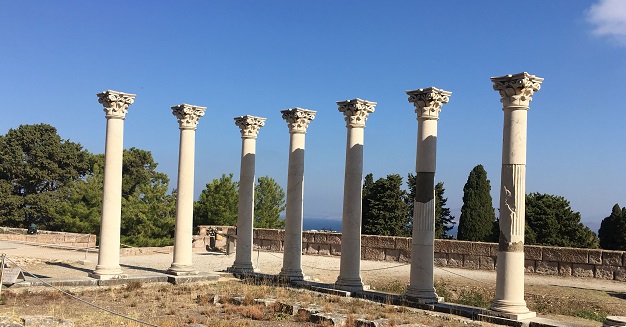
Join Thor and me as we return to Kos, the island of Hippocrates, and its ancient sanctuary of healing dedicated to the god Asklepios.
NOTE: Of course, Thor and I had to make another trip to Greece, as he’s fallen as much in love with the islands as I am. This time I wanted to return to Crete after 37 years, to introduce Thor to “glorious Kriti” and research more settings for my novel-in-progress, THE ARIADNE DISCONNECT. After time-traveling via ruins and museums to explore the mysterious, vanished Minoan culture, we went ferry-hopping to relax on a couple of our favorite islands.
If you recall from my post here of April 25, Thor and I left Rhodes on the afternoon ferry, eager to return to the serene island of Kos with its wealth of history, mythology, and of course our favorite pebble beaches inviting us into the magical blue sea.
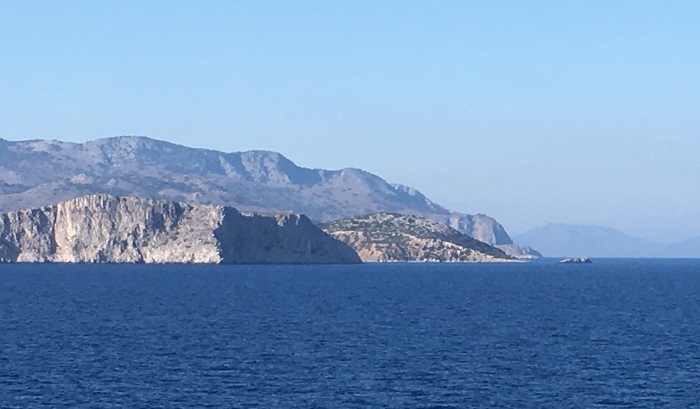
After settling in, we returned in the morning for a repeat visit to the beautiful ancient site of the asklepion, a healing center that drew patients and pilgrims from near and far for hundreds of years. It’s a setting in my novel-in-progress, and I wanted to soak up its soothing ambiance one more time.
“There are places benign and places baleful; and I seem to remember that in the treatise on Soils, Airs, Waters attributed to Hippocrates himself, the doctor-saint of Kos makes some attempt to describe the often fortuitous combination of the three elements necessary to create a site with natural healing properties.” (Lawrence Durrel, The Greek Islands) The Sanctuary of Asklepios on Kos certainly fulfills these requirements. Like the equally renowned ancient sanctuary of Epidauros in the Pelopponese, this site of healing exudes a nurturing sense of tranquility that welcomed Thor and me as we stepped into its morning quiet.
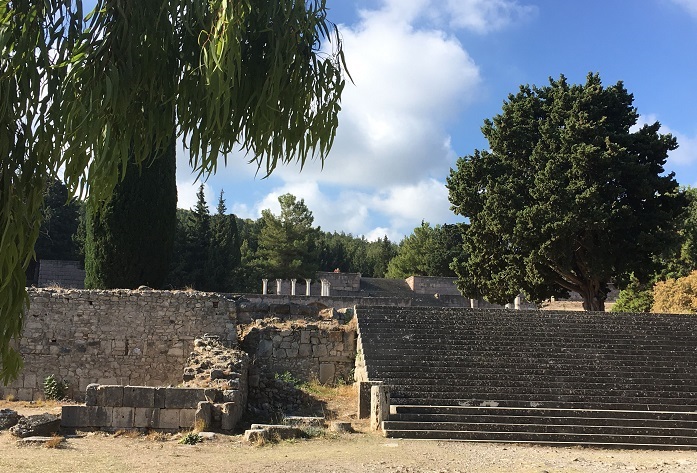
We arrived when the site first opened on a lovely October morning, when there were only a few other people there, and everyone seemed to respect the quiet beauty of this place perched in the pine-forested hills with a view over the sea to the nearby coast of Turkey.
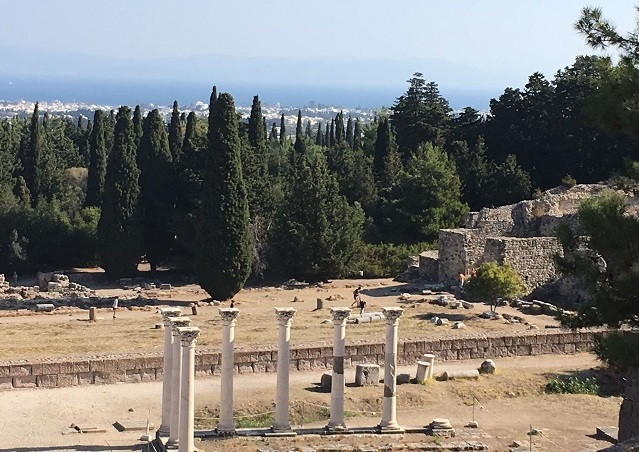
Asklepios emerged as a gentle healer-god in the Mediterranean region around 1500 BC, and with the later emergence of the Olympian pantheon was incorporated as the son of Apollo and the mortal Koronis. He was worshipped with rituals at over 300 healing centers, drawing supplicants from the 6th century BC through around 400 AD. His staff, the caduceus, wrapped by either one or two sacred serpents, became a symbol of healing still used today in the medical professions. Here is his famous statute from the Rhodes Museum of Archaeology:
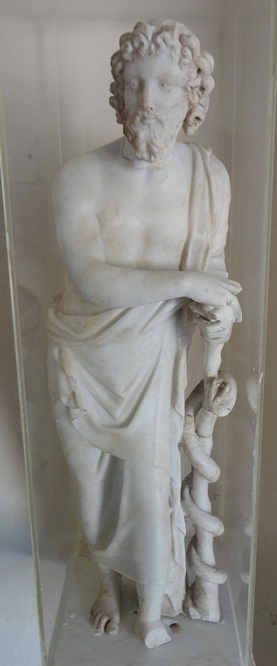
His daughter Hygieia was the personification of Health. We admired her lovely statue in the Kos Town Museum of Archaeology:
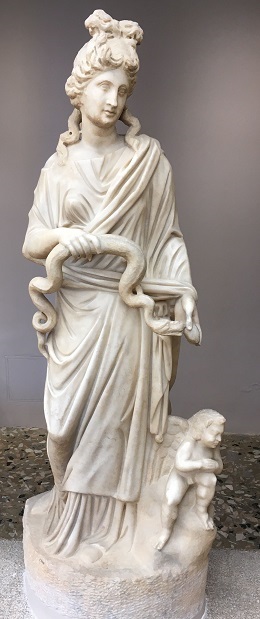
The Kos sanctuary was first established around the late 5th century BC, although worship at the site dates from Mycenaean times (around 1550 BC). It climbs the hillside in three terraces. The photo below, taken from the highest terrace, shows the Corinthian columns of a later Roman temple from the 2nd/3rd century AD. On the lower terrace, to the right, are the remains of the stoa and abaton sleeping quarters for the pilgrims who sought healing. The healings involved incubation: The ill would sleep overnight while visited by sacred serpents who would lick or touch them to induce dreams that would generate insight for the necessary cures. Years ago, when walking through a meadow on one side of the Epidauros Asklepion in mainland Greece, I met some of the local serpents, but kept a respectful distance….
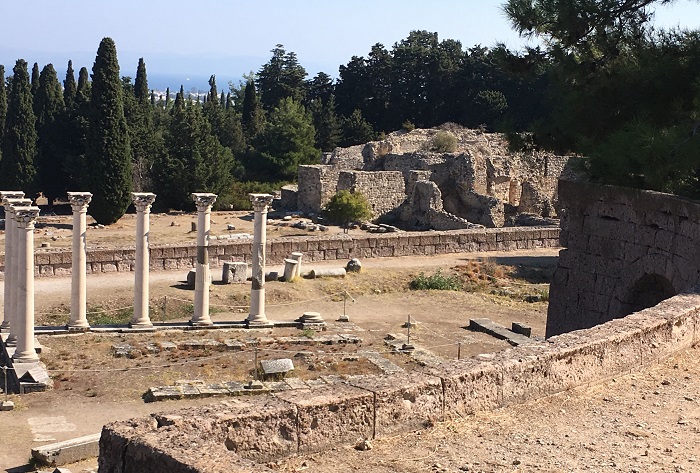
Here’s the layout of the Kos site:
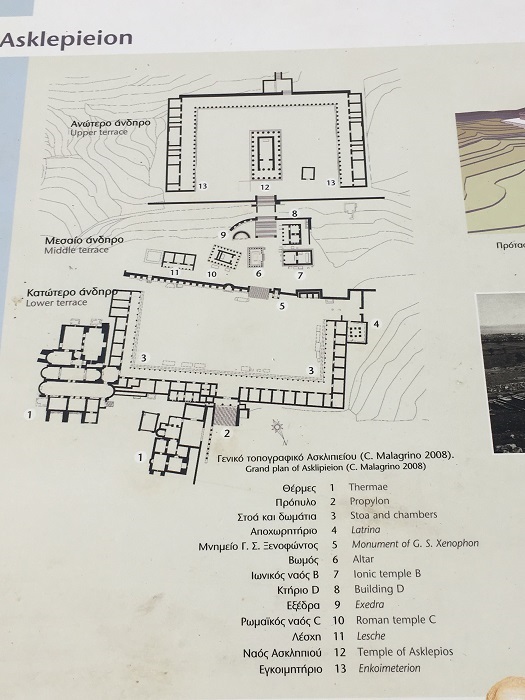
The upper terrace held the Temple of Asklepios (with different buildings from different periods). The middle terrace, supported by an impressive wall of arches, held the later Roman temple and the Altar of Asklepios where offerings to the god were burned.
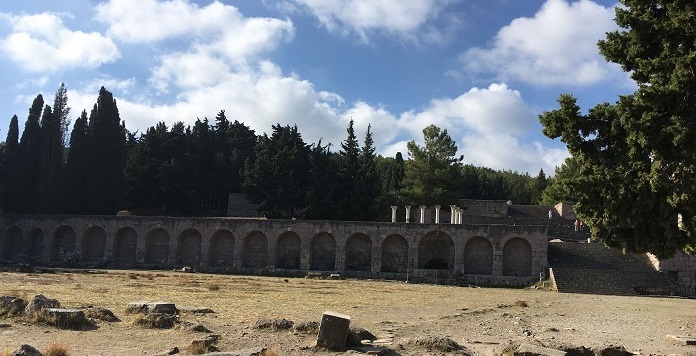
One of Hippocrates’s important healing elements, a mineral spring, was channeled through this outlet in the archway wall. A small carving of a goat-footed satyr playing pan-pipes presides over the outlet, and the moisture still supports moss and ferns.
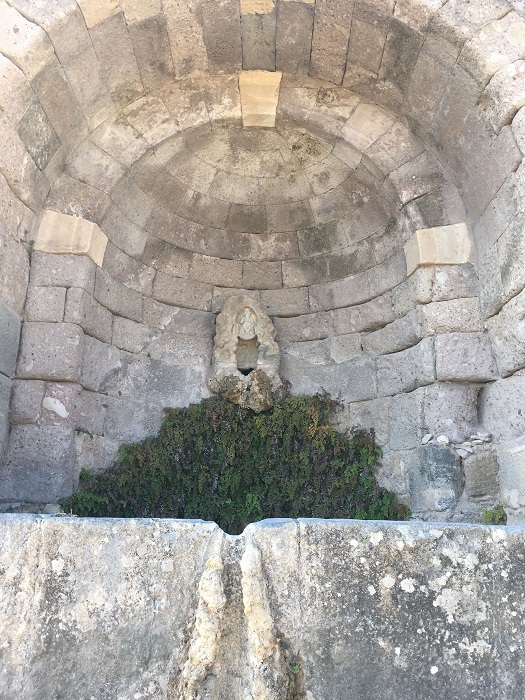
The Altar of Asklepios from the 3rd century BC:
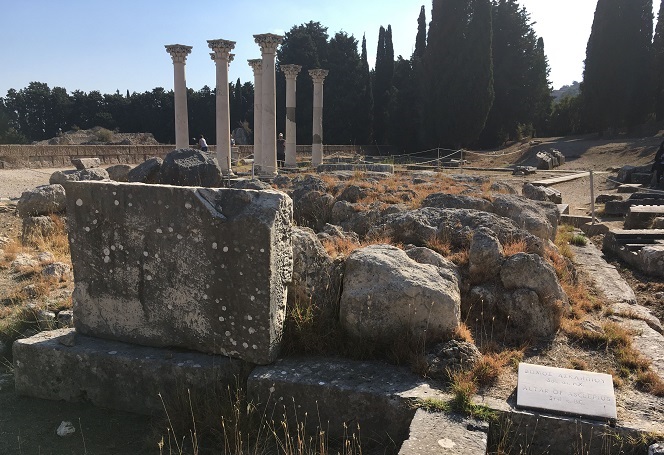
There isn’t much left of the 3rd-century BC Temple of Asklepios on the upper terrace:
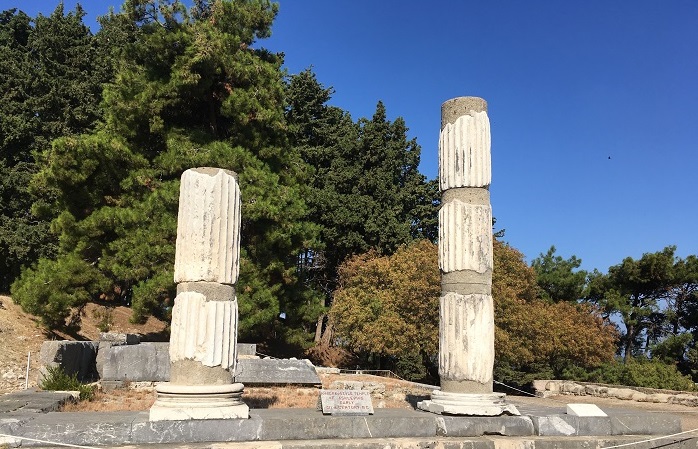
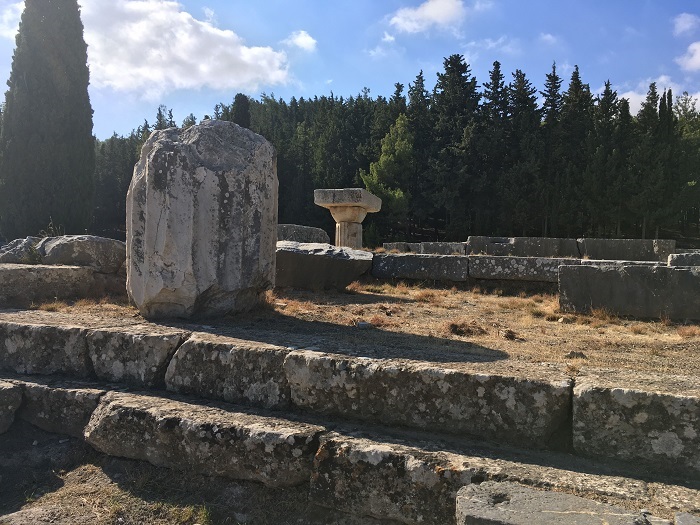
Here are interpretations of the temple as it existed. The smoke in the illustration is from burnt offerings on the altar in the middle terrace.
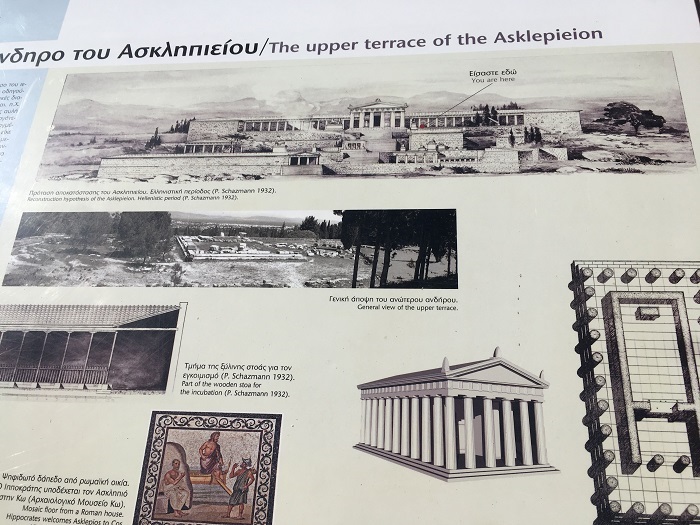
As Durrell notes in his musings on Kos, more important than the temple buildings is the serenity of place. I sat quietly for some time in the shade of the forest bordering the upper terrace, simply gazing out over the hillside and the sea, soaking in the atmosphere that inspired the “father of modern medicine” Hippocrates.
Tradition holds that Hippocrates was the 18th generation in the lineage of Asklepios, all healers who had followed the ways of the god. Hippocrates, born on Kos around 460 BC and educated during the Classic period, adopted a more rational approach to healing. He established medical schools and formulated his famous precepts for physicians, including the Hippocratic Oath still used when doctors swear to “do no harm.” Here is his larger-than-lifesize 4th century BC statue in the Kos museum:
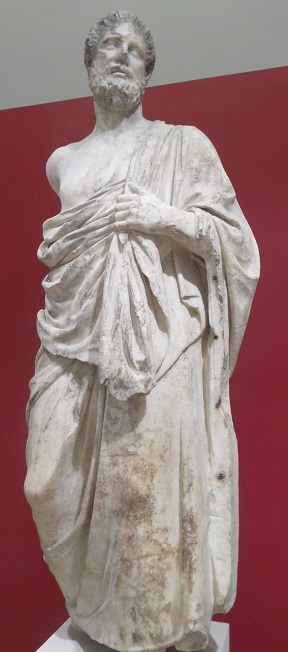
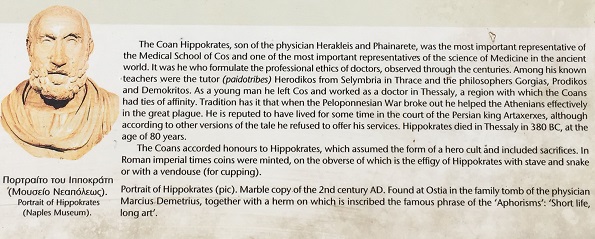

This Roman mosaic in the Kos museum, dated 2nd-3rd century AD, depicts the god Asklepios arriving on Kos to be greeted by Hippokrates, seated, and a standing Koan:
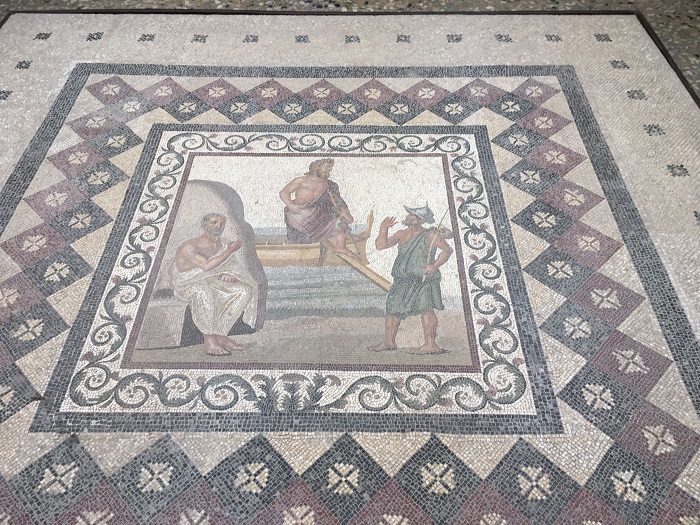
The museum also displays ancient medical implements:
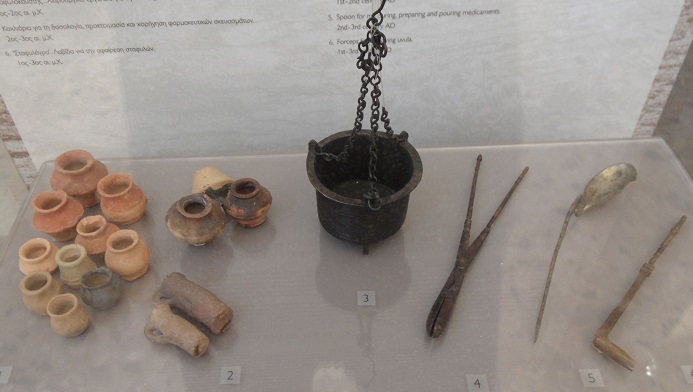
If you’d like to see more of the treasures in the lovely Kos museum, as well as a tour of a reconstructed Roman villa with more mosaics, see my blog series here from 2018. On that previous visit, Thor had a mission to collect leaf samples from the famous Hippocrates Plane Tree in a courtyard in Kos Town. (Unfortunately, the adjoining mosque was damaged in a recent earthquake in this region of the earth-shaker god Poseidon.) The current tree is thought to be descended from a tree originally planted by Hippocrates, and medical schools throughout the world still plant shoots obtained from this tree. A colleague of Thor’s was studying the effects of different environments on plants with identical DNA, so Thor enjoyed contributing to the scientific heritage started by Hippocrates.
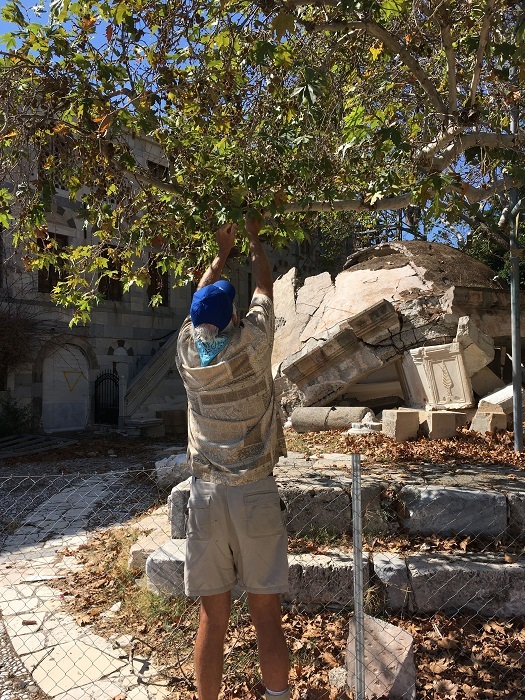
Next week: Beautiful beaches of Kos!
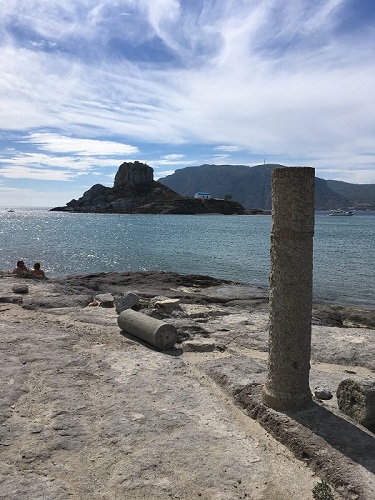
*****
You will find The Rambling Writer’s blog posts here every Saturday. Sara’s latest novel from Book View Cafe is available in print and ebook: The Ariadne Connection. It’s a near-future thriller set in the Greek islands. “Technology triggers a deadly new plague. Can a healer find the cure?” The novel has received the Chanticleer Global Thriller Grand Prize and the Cygnus Award for Speculative Fiction. Sara has recently returned from another research trip in Greece and is back at work on the sequel, The Ariadne Disconnect. Sign up for her quarterly email newsletter at www.sarastamey.com


1 thought on “The Rambling Writer’s Greek Islands 2019, part 4: The Healing Asklepion on Kos”